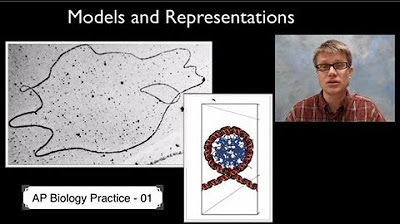2.7 Facilitated Diffusion - AP Biology
Summary
TLDRIn this engaging AP Biology lesson, Mr. Poser explores facilitated diffusion and active transport, key concepts in cell membrane function. He explains how molecules pass through the lipid bilayer, emphasizing the role of transport proteins like channel and carrier proteins. The discussion includes the significance of ions, membrane potential, and the sodium-potassium pump, highlighting their contributions to maintaining a cell's resting potential. Additionally, the concept of co-transport is introduced, illustrating how existing gradients help move larger molecules into cells. This comprehensive overview provides a solid foundation for understanding cellular transport mechanisms.
Takeaways
- 😀 Facilitated diffusion is a type of passive transport that does not require energy but involves transport proteins.
- 🌊 Small nonpolar molecules like oxygen and carbon dioxide can passively diffuse through the cell membrane, while charged ions need specific channels.
- 🔌 The cell membrane maintains a voltage difference, known as membrane potential, which is essential for cell function.
- 📏 Concentration gradients and electrical charges work together to create an electrochemical gradient that influences ion movement.
- ⚙️ Gated channels open in response to specific stimuli, allowing ions to cross the membrane during facilitated diffusion.
- 🔋 A cell's resting potential is typically around -70 millivolts, indicating a negative charge inside the cell compared to the outside.
- 💡 The sodium-potassium pump is a crucial active transport mechanism that helps re-establish membrane potential by pumping sodium out and potassium in.
- 🌡️ Electrogenic pumps like the sodium-potassium pump generate voltage across the membrane and are vital for maintaining cellular homeostasis.
- 🔄 Co-transport involves using an electrochemical gradient to help transport molecules like sucrose against their concentration gradient.
- 🤝 The movement of hydrogen ions can drive the co-transport of larger molecules, allowing cells to bring in essential nutrients.
Q & A
What is facilitated diffusion?
-Facilitated diffusion is a type of passive transport that allows molecules to cross the cell membrane with the help of transport proteins, such as channel and carrier proteins, without using energy.
How do small, nonpolar molecules pass through the cell membrane?
-Small, nonpolar molecules can passively diffuse through the lipid bilayer of the cell membrane due to their compatibility with the hydrophobic nature of the membrane.
What are the two main types of transport proteins involved in facilitated diffusion?
-The two main types of transport proteins are channel proteins and carrier proteins, which assist in the movement of specific molecules across the cell membrane.
Why can't ions pass through the lipid bilayer by themselves?
-Ions are charged molecules and cannot pass through the hydrophobic lipid bilayer without assistance due to the repellent nature of the nonpolar tails of phospholipids.
What role do gated channels play in ion transport?
-Gated channels are specialized proteins that open in response to specific stimuli, allowing ions like sodium and potassium to move across the cell membrane according to their electrochemical gradients.
What is membrane potential and how is it established?
-Membrane potential is the voltage difference across a cell membrane, created by the distribution of ions on either side of the membrane, particularly sodium and potassium.
What is the resting potential of a typical cell?
-The resting potential of a typical cell is measured at approximately negative 70 millivolts, indicating a difference in charge across the membrane.
How does the sodium-potassium pump function?
-The sodium-potassium pump uses ATP to actively transport three sodium ions out of the cell and two potassium ions into the cell, helping to maintain the electrochemical gradient.
What is the significance of the electrochemical gradient?
-The electrochemical gradient is important because it combines the effects of concentration gradients and voltage differences, driving the movement of ions across the membrane and influencing cellular activities.
How does cotransport work in relation to facilitated diffusion?
-Cotransport involves using an electrochemical gradient, often created by a proton pump, to bring other molecules, like sucrose or glucose, into the cell against their concentration gradient by coupling their transport with ions moving down their gradient.
Outlines

This section is available to paid users only. Please upgrade to access this part.
Upgrade NowMindmap

This section is available to paid users only. Please upgrade to access this part.
Upgrade NowKeywords

This section is available to paid users only. Please upgrade to access this part.
Upgrade NowHighlights

This section is available to paid users only. Please upgrade to access this part.
Upgrade NowTranscripts

This section is available to paid users only. Please upgrade to access this part.
Upgrade NowBrowse More Related Video

2.6 Membrane Transport - AP Biology

7 Things to Know about DNA structure

2.10/2.11 - Compartmentalization/Origins of Compartmentalization - AP Biology

AP Biology Practice 2 - Using Mathematics Appropriately

3.1/3.2 Enzyme Structure + Catalysis - AP Biology

AP Biology Science Practice 1: Models and Representations
5.0 / 5 (0 votes)